




Your support is critical to our success.
Accepted Scientific Name: Cycas micholitzii Dyer
Gard. Chron. , ser. 3, 38: 142 (1905)
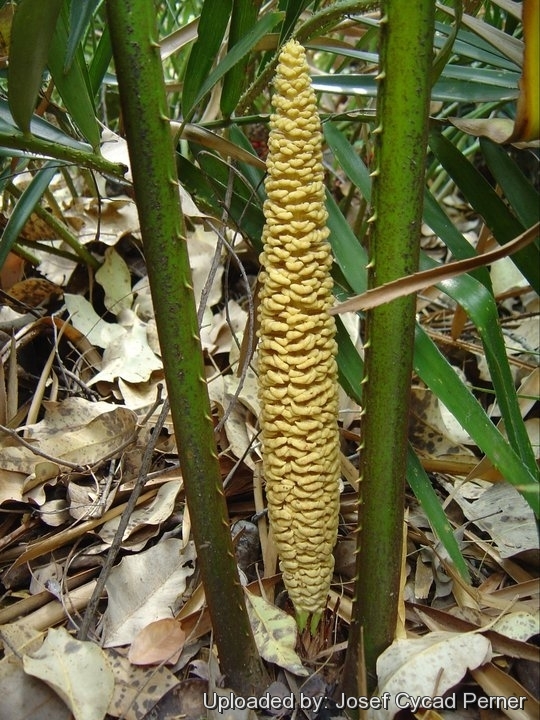
The male cones are small, slender obovate-oblong to fusiform-cylindric, yellow, 15-25 long, 3-6 cm in diameter, with distinct very short spines on the microsporophyll tips.
Origin and Habitat: Cycas micholitziiSN|28863]]SN|31816]] grows mainly in the Annam Highlands region of central Viet Nam, eastern Lao, and in the Longzhou District of Guanxi Province and Honghe River Valley in China (possibly it occurs in Myanmar and Thailand too). The species is relatively common, but individual plants are usually wide spaced. Cycas micholitziiSN|31816]]SN|31816]] is sympatric with Cycas pectinataSN|31816]]SN|28863]].
Altitude range: It has been recorded from 130 to 600 metres above sea level.
Habitat and Ecology: This species grows in low, scrubby but fairly dense woodland and prefers a warm, moist climate with substantial seasonal rainfall (monsoon) and additional year-round montane rainfall where the annual rainfall is above 1500 mm. This climate is warm and hot in the summer and warm and frost-free in the winter. This species prefers semishady places in the tropical jungle and is not tolerant of direct, strong sunlight. The vegetation can also be decribed as semi-shaded thickets and broad-leaved monsoon forests, it is also found in bamboo bush on sandy soil. Cycad pollination was long thought to be a chance event, effected only by the wind. This was especially troublesome for understanding the success of understory cycads in tropical forests, where there is little wind, and where pollen studies have shown that there is almost no cycad pollen in the air. More recent investigations have suggested that beetles, especially weevils, and small bees may make a more important contribution to the transfer of pollen. A large portion of the habitat of C. micholitzii has been cleared in Viet Nam, and is endangered in China as a result of over collection by commercial dealers and habitat destruction. The invasion of alien grasses into areas of native vegetation and too frequent fires may be also a possible threat, however the underground cycad trunks survive occasional fires and sprout new leaves during the growing season, but appears that only big trunks and the ones deep enough under ground escape the fires. This species is still, however, frequent in many places, and not considered to be immediately at risk.
Synonyms:
- Cycas micholitzii Dyer
- Dyerocycas micholitzii (Dyer) Nakai
- Epicycas micholitzii (Dyer) de Laub.
ENGLISH: Micholitz sago, Micholitzi's sago, Fork-leaved cycas
CHINESE (中文): 叉叶苏铁, cha ye su tie, Long kou su tie
FRENCH (Français): Cycas à feuilles fourchues
Description: The Micholitz’s Cycad (Cycas micholitzii) is an extraordinary and bizarre cycad with a short trunk-like caudex mostly subterranean (acaulescent ) or rarely above-ground that grow very slowly up to 20(-60) cm tall in a life span that may stretch more than 120 years. Uniquely, the leaflets are bi-pinnate, in other words they split dichotomously, two or three times, giving a most un-cycad like appearance, making it one of the smallest of the few Cycas species with branched leflets. Dichotomously divided leaflets also occurs in several related taxa, and in a horticultural form of Cycas revolutaSN|31819]]SN|23433]] that is popular in Japan. The ultimate size of the whole plant is usually only a few metres tall. The subterranean habit, the small, soft microsporangiate cones, the loose, freely peeling sarcotesta lacking a fibrous layer and the verrucose sclerotesta are also all features shared by related species. Within this group of related species (see also: Cycas multipinnataSN|23433]]SN|31819]] and Cycas simplicipinna), C. micholitzii is distinguished by the short leaves with dull, comparatively short and narrow leaflets that are dichotomously divided very near to the base, and small pollen cones with distinct very short spines on the microsporophyll tips.
Derivation of specific name: The specific name honours W Micholitz (1854-1932), who made the type collections. Micholitz was a plant and insect collector who collected extensively in Asia and New Guinea.
Stems: Mostly subterranean, dwarf and the ultimate size of the trunk is usually only 20-60 cm tall and 10-15(-20) cm in diameter above ground, base swollen. The bark is dark grey, scaly with cataphylls, except at base of trunk where nearly smooth.
Leaves (fronds): (2-)3-6(-8) in crown, bipinnate, flat, bright green, semiglossy or dull, often glaucous when young, (1-)2-4(-5) m long, 40-60(-80) cm wide (The leaves of the Vietnam form of this species are shorter than the Chinese variety, growing to less than two meters instead of five for the Chinese one). Petiole 0.5-1(or more) metres long (40-55% of total leaf), glabrous, with sparse, short spines. Leaf blade, flat moderately keeled. Leaflets 18-56, opposite, inserted at 90-120° on rachis, with white tomentum shedding as leaf expands, dichotomously divided, 1 (-3)-forked into 1 or 2(or 3) segments. Segments linear, often irregular, papery, base constricted into a short petiolule 0.5-5 cm long, decurrent, margin somewhat undulate, apex attenuate to long acuminate. Basal leaflets not gradually reducing to spines mostly 23-33 cm long. Median leaflets dichotomously branched, strongly discolorous, 23-36 cm long, 1.1-1.9 mm wide, inserted at 60° to rachis, narrowed to 2-3 mm at base (to 10-20% of maximum width), 35-60 mm apart on rachis; median leaflets section flat; margins flat; apex softly acuminate, not spinescent; midrib raised above, flat below. Rachis terminated by paired leaflets
Cataphylls: The cataphylls (Modified leaf, much reduced and thickened, serving to protect the apical meristem in cycads produced in flushes preceding the emergence of cones or leaves.) are broadly deltoid, 3-5(-8) cm long, 4-5 cm wide, densely brown velutinous, articulated.
Male cone: Slender obovate-oblong to fusiform-cylindric, yellow, 15-25 long, 3-6 cm in diameter. Microsporophylls 1.2-2 cm × 8-10 mm, tomentose, apex acute. Microsporophyll lamina soft, not dorsiventrally thickened, 13-18 mm long, 7-11 mm wide, apical spine prominent or rudimentary, sharply upturned, 1-6 mm long. Sporophylls from the base to the middle of microsporophyll.
Megasporophylls: Like other Cycas species, the female plants do not bear cones; instead they carry ovules and seeds on brown tomentose or glabrescent megasporophylls that are leaflike pinnate structures 8-12 cm long, that bear 1 or 2 lateral ovules on each side of the margins of the lamina with the micropyles of the ovules directed away from the axis of the sporophyll. Stalk ca. 4 cm long. Sterile blade obovate/peltatae, ca. 4 cm long and 3 cm wide, deeply divided into 13-17 subulate lobes (pectinate) 1-2 cm long.
Seeds: 2-4, greenish to yellowish, ovoid to obovoid, slightly compressed, 2.3-2.8 long, 1.8-2.4 cm thick. Sclerotesta finely verrucose, apex mucronate. Fibrous layer absent. Spongy endocarp absent.
Phenology: Pollination Apr-May, seed maturity Oct-Nov.
Chromosome number: n = 9.
Cotyledones: 2
Subspecies, varieties, forms and cultivars of plants belonging to the Cycas micholitzii group
Cycas simplicipinna, Cycas micholitzii, Cycas bifida and Cycas multipinnata forms a group. C. simplicipinna has undivided pinnae, whereas C. micholitzii and Cycas bifida have pinnae that are once dichotomous, and C. multipinnata has pinnae that are two to five times dichotomous. Thus there is a transformation series from simple to dichotomous to multidichotomous. This phenomenon becomes even more interesting when examining the development from seedling to adult of individual plants of C. micholitzii and C. multipinnata. In C. micholitzii, the first leaf has undivided pinnae, the second leaf has one dichotomous pinnae. In C. multipinnata, the first leaf has undivided pinnae, the second leaf has one dichotomous pinnae, the third through fifth leaves have a pinnae where one of the dichotomies is itself dichotomous resulting in a tripartite pinnae, and the sixth and subsequent leaves have pinnae with multiple dichotomies resulting in leaves that have a minimum of three dichotomies per pinna. Thus, we not only have a transformation series between species but also within a species.
 Cycas bifida (Dyer) K.D.Hill: has few arching fronds with long petioles shooting out of a small, dome-shaped caudex and glossy leaflets bifurcated very near to the base. Distribution: China (Guangxi, Yunnan) and northern Viet Nam (Cao Bang, Lang Son and Tuyen Quang).
Cycas bifida (Dyer) K.D.Hill: has few arching fronds with long petioles shooting out of a small, dome-shaped caudex and glossy leaflets bifurcated very near to the base. Distribution: China (Guangxi, Yunnan) and northern Viet Nam (Cao Bang, Lang Son and Tuyen Quang).  Cycas micholitzii Dyer: is mostly stemless with, erect fronds, comparatively short and narrow leaflets are bi-pinnate, in other words they split dichotomously, two or three times, giving a most un-cycad like appearance. Distribution: China, Vietnam and Laos.
Cycas micholitzii Dyer: is mostly stemless with, erect fronds, comparatively short and narrow leaflets are bi-pinnate, in other words they split dichotomously, two or three times, giving a most un-cycad like appearance. Distribution: China, Vietnam and Laos.- Cycas multipinnata C.J.Chen & S.Y.Yang
 Cycas simplicipinna (Smitinand) K.D.Hill: is mostly stemless with large, erect fronds with broad and well-spaced undivided leaflets, small microsporangiate cones, small megasporophylls with short spines on the apical lamina. Distribution: China,Viet Nam and Thailand.
Cycas simplicipinna (Smitinand) K.D.Hill: is mostly stemless with large, erect fronds with broad and well-spaced undivided leaflets, small microsporangiate cones, small megasporophylls with short spines on the apical lamina. Distribution: China,Viet Nam and Thailand.
Bibliography: Major references and further lectures
2) Boris Lariushin “Cycadaceae Family” Lulu.com
3) A. C. Seward “Fossil Plants: a Text-book for Students of Botany and Geology.” Vol. III, CUP Archive 1917
4) The Cycad Pages “Cycas micholitzii” Royal Botanic Gardens Sydney Written and maintained by Ken Hill 1998-2010 Maintained by Leonie Stanberg and Dennis Stevenson 2010-2012 <http://plantnet.rbgsyd.nsw.gov.au/cgi-bin/cycadpg?taxname=Cycas+micholitzii> Web. 25 August 2015
5) V.P. Singh “Gymnosperm (naked seeds plant) : structure and development” Sarup & Sons, 01 January 2006
6) “The Biology, Structure, and Systematics of the Cycadales: Proceedings of the Symposium CYCAD 87”, Beaulieu-sur-Mer, France, April 17-27, 1987, Volumi 54-57 New York Botanical Garden, 1990
7) Nakai Takenoshin “Ordines, familiae, tribi, genera, sectiones, species, varietates, formae et combinationes novae a Prof. Nakai-Takenosin adhuc ut novis edita. Appendix. Quaestiones characterium naturalium plantarum vel Extractus ex praelectionibus pro aluminis botanicis Universitatis Imperialis Tokyoensis per annos 1926–1941” Alexander Doweld, 20 lug 1943
8) Nguyen, H.T. 2010. Cycas micholitzii. The IUCN Red List of Threatened Species. Version 2015.2. <www.iucnredlist.org>. Downloaded on 04 September 2015.
9) Si-Lin Yang “Vietnam Cycad and Palm Expedition (Part II)” PALMS & CYCADS, No. 50 Jan-Mar 1996
10) Whitelock, Loran M., “The Cycads”, Timber press, 2002.
11) Haynes J.L, “World List of Cycads: A Historical Review”, IUCN/SSC Cycad Specialist Group, 2012
12) Jones, D. L. “Cycads of the world, ancient plants in today's landscapes.” 1993.
13) Flora of China “3. Cycas micholitzii Dyer, Gard. Chron., ser. 3. 38: 142. 1905. 叉叶苏铁 cha ye su tie” FOC Vol. 4 Page 3 <http://www.efloras.org> Web. 25 August 2015
14) "Cycads: Life History and Ecology" <http://www.ucmp.berkeley.edu/seedplants/cycadophyta/cycadlh.html> Web. 25 August 2015
15) Barbara A. Ambrose, Michael D. Purugganan “Annual Plant Reviews, The Evolution of Plant Form” John Wiley & Sons, 21 November 2012
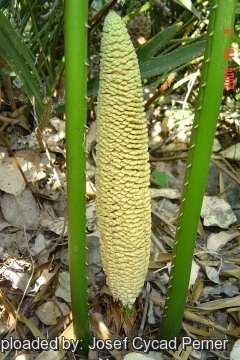
Epicycas micholitzii (Cycas micholitzii) Photo by: Josef Cycad Perner
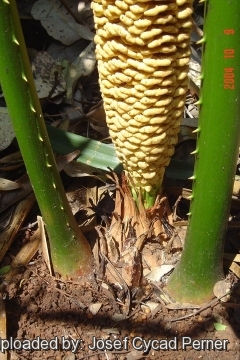
Epicycas micholitzii (Cycas micholitzii) Photo by: Josef Cycad Perner
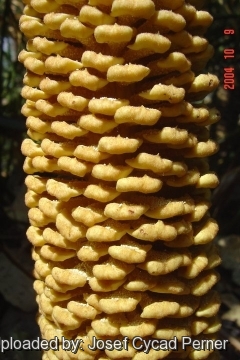
Microsporophylls. (Cycas micholitzii) Photo by: Josef Cycad Perner
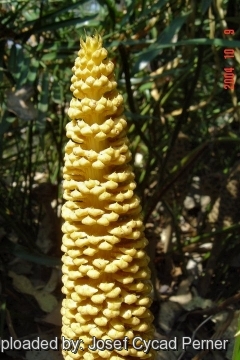
Microsporophylls. (Cycas micholitzii) Photo by: Josef Cycad Perner
Cultivation and Propagation: Cycas micholitziiSN|31816]]SN|31816]] is extremely rare in cultivation and found only in specialized cycad collection and botanical gardens and a perfect specimen for the conservatory. It is suited to tropical regions which have a seasonally dry climate. It is easy to grow, tolerating short dry periods. It is attractive as a young plant because of the elegant feathery fronds. Cycas micholitziiSN|31816]]SN|31816]]is suited to pot culture. The rarity combined with the unusual habit make it a very highly sought plant by collectors.
Exposure: It will do well in a shaded spot in the subtropical and tropical garden, colour bleaches when in full sun, best with protection from afternoon heat.
Soil: Needs a well drained spot, with deep soil, but will still thrive in less than ideal conditions.
Fertilizaton: Because of its growth habit, fertilize only when terminal bud begins to swell, indicating the start of the annual growth cycle.
Maintenance: Minimal; removal of offsets if desired, removal of spent fronds.
Hardiness: This species is probably a tropical in its needs.
Use: Landscape as cultivated perennial in warm, coastal areas. House-plant or interior-scape, as container plant in cool areas.
Warning: Petiolar spines are short and well spaced, but still sharp so take care when pruning. All plant parts are considered highly toxic.
Propagation: Seed. As a slow growing plant, the seed can take from 6–18 months to germinate. After fertile seeds are collected, they usually need several months of storage before the inner embryo is ready to germinate. Therefore, it is best to clean the seeds of external fruit and set them aside before attempting to propagate the seeds. Usually seeds are ready to germinate after 2-4 month, the germination is rapid and almost all seeds germinate up within 2 month.
| Your Actions | |
|---|---|
| Back to Epicycas index | |
| Back to Cycadaceae index | |
 |
Back to Palms And Cycads Encyclopedia index |
Privacy stantement - Terms and conditions - How to cite - About us - Feedback - Donate


